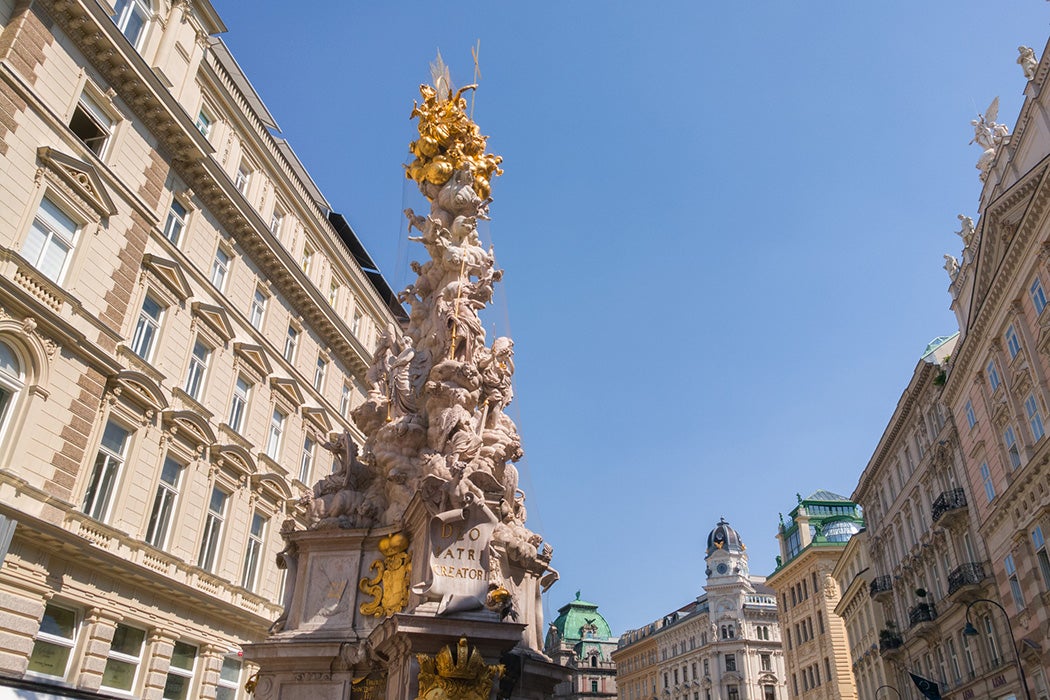In recent weeks, a column erected to symbolize victory over a seventeenth-century plague has become a site of prayer and pilgrimage amid COVID-19. As reported by Euronews, residents in Vienna have been visiting the Plague Column—or the Pestsäule—to leave candles, tokens, and messages asking for protection.
The Plague Column is a prominent monument and symbolizes past resilience in times of disease, something that resonates in the current pandemic. It was erected following a devastating outbreak in 1679. In the Bulletin of the History of Medicine, epidemiologist Edward A. Eckert writes that in Austria it was “referred to as the Great Plague” with Vienna reporting 60,000 burials, “about half” of the city’s inhabitants.
While the fourteenth-century Black Death pandemic was the most fatal of the plague outbreaks, the disease would recur over the following centuries, including in Vienna. In 1679, the density of the city, the lack of any public sewers, and the refuse that encouraged an infestation of rats all contributed to a terrible epidemic. Available treatments were limited to bloodletting, induced vomiting, and the most basic of care, administered by the Brotherhood of the Holy Trinity religious order; large pits were excavated and heaped with the dead. In Reviews of Infectious Diseases, medical history scholars Boris Velimirovic and Helga Velimirovic cite this account:
Pains and suffering were heightened when each went out of the path of his friend, even blood relatives could not visit or help one another in their need…often the seven gates of the city were not enough to carry out the sick and the dead…bearers became fewer, and the drum was beaten daily to hire others, for increased pay…because of the lack of bearers of the sick, prisons were opened and prisoners, even persons incarcerated for life, were forced to the gruesome task.
When this harrowing time finally ended, the city felt as if it had been divinely saved. Soon, a lavish monument would rise to remember those who died and give thanks for those who survived.
Commissioned by Habsburg emperor Leopold I, who, like the elite always have, had fled the epidemic, the Plague Column completed in 1693 is a Baroque confection of saints, angels, and its royal benefactor in prayer. Musicology scholar Janet K. Page, in Early Music, describes it as “topped with a gilded representation of the Holy Trinity, and on one side it depicts a kneeling Leopold I, who had conquered the plague through his ‘victorious faith’…it was customary to bend the knee when passing it.”
Weekly Newsletter
Although Vienna’s Plague Column is one of the most famous, and inspired many that came after with its cloud of heavenly hosts in an obelisk-like shape, it follows a tradition of votive columns that dates back to antiquity. It also elaborated on the columns that were already being built during times of pestilence. “Wooden columns were customarily erected during plagues, for the use of flagellants,” historian Frances D. Fergusson writes in the Journal of the Society of Architectural Historians, referring to those who whipped their body as a devotional punishment as an attempt to drive away the plague. “In Austria, the columns were monumentalized during the last half of the seventeenth century,” and by “the early eighteenth century, permanent plague columns were found in almost all Austrian cities and towns.”
Others still stand around Central Europe. Košice, Slovakia, has the “Immaculata” from 1723, commemorating the end of a 1709–19 plague; Baden, Austria, has a column created after a 1713 plague. One from 1650 in Prague’s Old Town Square was torn down in 1918, as it was seen as a symbol of the Habsburgs. As architect Andrew Shanken relates in Future Anterior: Journal of Historic Preservation, History, Theory, and Criticism, Klagenfurt, Austria, relocated its eighteenth-century plague column to a new pedestrian area as “part of the reinvention of the town, and especially its historical center, in the postwar period,” a symbol of rebuilding after the city was bombed forty-seven times and about 70 percent of its buildings were destroyed. Everywhere these plague columns are preserved, they are reminders of past moments of death and disease, and how people survived.
Support JSTOR Daily! Join our new membership program on Patreon today.







